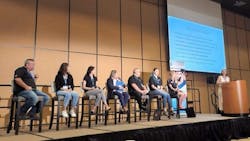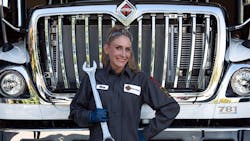The 21st century has brought new challenges and demands to every industry in the United States, and the automotive repair industry is no exception. In addition to meeting the demands of rapidly-changing technologies, a shifting consumer base, and uncertain economic and supply-chain conditions, the industry sees the importance of developing a workforce capable of meeting those demands. One of the key components to realizing that goal is bringing more women into the industry in roles where they have been lacking, specifically as service technicians. The challenge is more complicated than it may seem on the surface, and there are numerous obstacles to navigate as industry leaders seek to develop a workforce that not only resembles society at large, but also possesses the skills and desire to create successful and rewarding careers.
See also: Why are shops still a 'no woman’s land'?A lively and informative panel discussion, focused on making training programs and workplaces more welcoming to everyone, kicked off the in-person ASE Instructor Training Conference held recently in Frisco, Texas. The keynote panel discussion, titled The 2 Percent Solution, featured several female automotive service professionals, students, and instructors.
The session was moderated by Catherine “Cat” Treanor, U.K. business development manager for Electude. The other panelists included Missy Albin, a Navistar master diesel mechanic at Taylor & Loyd; Lou Bramante, an automotive instructor at Vineland Senior High School; Raven Hartkopf, a collision discipline lead, Colin College; Jenny Kovacs, a Ford master technician; Joe Laubhan, service director at Classic Chevrolet; Vanessa Retsos, a Chevrolet service technician; and Paulina Sanchez, a shop owner and collision repair student at Colin College.
Facing challenges
As the session got underway, Mike Coley, president, ASE Education Foundation, stated that one of the problems that the automotive repair industry is facing is that women make up 50% of the workforce, but only 2% of service technicians.
“We’re telling half the population ‘You don’t need to apply for a job in this industry,’ but we have a technician shortage and it’s not like the chip shortage—it’s not going to get solved when the supply chain kinks get sorted out,” Coley said. “We need to work together to solve the technician shortage. We need to make the industry open and educational opportunities available for women and anybody else who wants to get involved.”
See also: FedEx Freight’s Pinter wins TMCSuperTech for 2nd time, while runner up Greenwood makes historyTreanor reiterated that the automotive repair industry has several big issues to overcome. “We have a shortage of technicians, an aging workforce, a negative stereotype, a lack of new talent, and a tidal wave of new technology,” Treanor said. “The answers to all these challenges is diversity. We need diversity of gender, ethnicity, of age, physical attributes, and more.”
Treanor pointed out that a diverse team can solve more problems more efficiently than one that isn’t. “It’s important to remember that everyone has strengths, but that we also all have weaknesses, and that’s why with diversity comes strength.”
During the two-hour discussion, Treanor and the panelists focused on some of the challenges that females face in school and in the workplace, including the perception of not being able to do the job, not being taken seriously, being stereotyped into a certain job, trying to get that first job, and the lack of support from others.
One of the key topics amongst the panelists was barriers that they have faced while working towards a career as an automotive repair technician. Albin said one of her biggest barriers was the lack of support and not having enough believers. She started her education at a four-year college studying graphic design, which she learned quickly wasn’t the career path for her.
“As a young child, I was always pulling things apart,” Albin recalled. “I was interested in knowing what things looked like on the inside or how they worked. There was a passion inside of me to find out who I was without being restricted or told ‘This is what you need to do because of society.’ For me, the passion to become a technician was built within me. It’s something that I didn’t need to really look for—I just needed to figure out how to express myself.”
When trying to get experience during high school, Kovac said one of the barriers that she encountered was getting her first hire. She explained that she interviewed for a job-shadowing position and that the interview quickly changed once she got to the dealership. She ended up being a night service cashier, so she didn’t gain any shop experience. The next place she went to try to get a technician job saw that she had experience answering telephones, so they thought the best job for her was in an office position as well.
“I think that’s one of the stereotypes that women face is ‘You look like you’d be better in a customer-facing position, so we’re going to push you in that direction,’” Kovac said. “As a technician, I was extremely valuable, and I just had to make people see that.”
Other barriers that the panel discussed included not being considered capable of being a service technician, that they aren’t being taken seriously as a female, a perception that females cannot do the job, continual rejection and not getting a chance to prove themselves, and being stereotyped into a certain role or type of position.
On the topic of stereotyping, Treanor asked the panel if there was anything intimidating about a career in the automotive repair industry or if they had any reservations. For Albin, using tools was intimidating at first because she didn’t have anyone to teach her how to properly use them.
“At first, I was afraid of anything pneumatic, with a wheel, but over the years, I lost the intimidation factor when somebody actually embraced how humiliated I was by not knowing how to use the tool properly,” Albin recalled. “How do you use the tool for the job? And which tool to use for the job? Overcoming that, I was able to flourish as a technician once I knew what tools were out there, how to use them, and when to use them.”
Talking about her own experience as a new technician, Treanor said that she never wanted to ask for help because she didn’t want to be seen as not knowing the answer, and that, she believes, was a big hindrance to her.
“A really classic stereotype that we all have to break and deal with every day is that people think we’re stupid or a grease monkey,” Treanor said of repair professionals. “It’s actually a science at the end of the day. What we’re doing is only going to get more complicated. Breaking stereotypes and what people think automotive is is a really good start.”
Knocking down barriers
The panel and the audience provided a wide array of suggestions to help increase the number of females in schools. The ideas included increasing shadowing opportunities, giving high school students the option to explore automotive classes to see if they like them, starting to reach females in middle school to encourage them to think about a career in the transportation industry, providing facts to potential students about the advantages of the industry and financial benefits they could achieve, creating a safe environment for students, eliminating the term ‘non-traditional,’ and working with administrators and counselors to encourage female students to participate in automotive programs.
Bramante said he creates a safe and inclusive space for his students through motivational signs throughout his classroom, and he lets students know from day one that they will not be bullied, harassed, or intimidated in his world.
“That’s the least that I can do is to provide a stable learning experience for all students,” Bramante said. “And it’s not just females, it’s all of my students, but the females get a sense of safety and belonging, and it doesn’t take a lot of effort.”
Other suggestions that were discussed included featuring women in the automotive repair industry in marketing materials like company posters, websites, and online advertisements, finding a role model or mentor for guidance, creating after-school programs for middle schools focusing on service repair, and creating clubs in high school for students to have a place to discuss automotive careers.
At the end of the discussion, Treanor asked the panelists what they would tell their younger selves. Albin responded, “I would tell my younger self that I’m worthy of my dreams and to not be nervous or scared to pursue them. And everybody that tells you no, just laugh at them instead of cry. It would be amazing to tell my younger self where I am today.”
Kovacs would tell her younger self, “You got this. And you don’t have to know everything from the start–nobody does. I wish I could show her that I made it."
About the Author

George Arrants
Training consultant, K&D Technical Innovations
George Arrants is the vice president for ASE Education Foundation. Arrants works with instructors and administrators to develop partnerships with local businesses and industries through program advisory committees. He is the past chair of the Technology and Maintenance Council’s TMCSuperTech, the National Technician Skills Competition, and TMCFutureTech, the National Student Technician Competition. His entire career has been in the automotive service and education industries.


